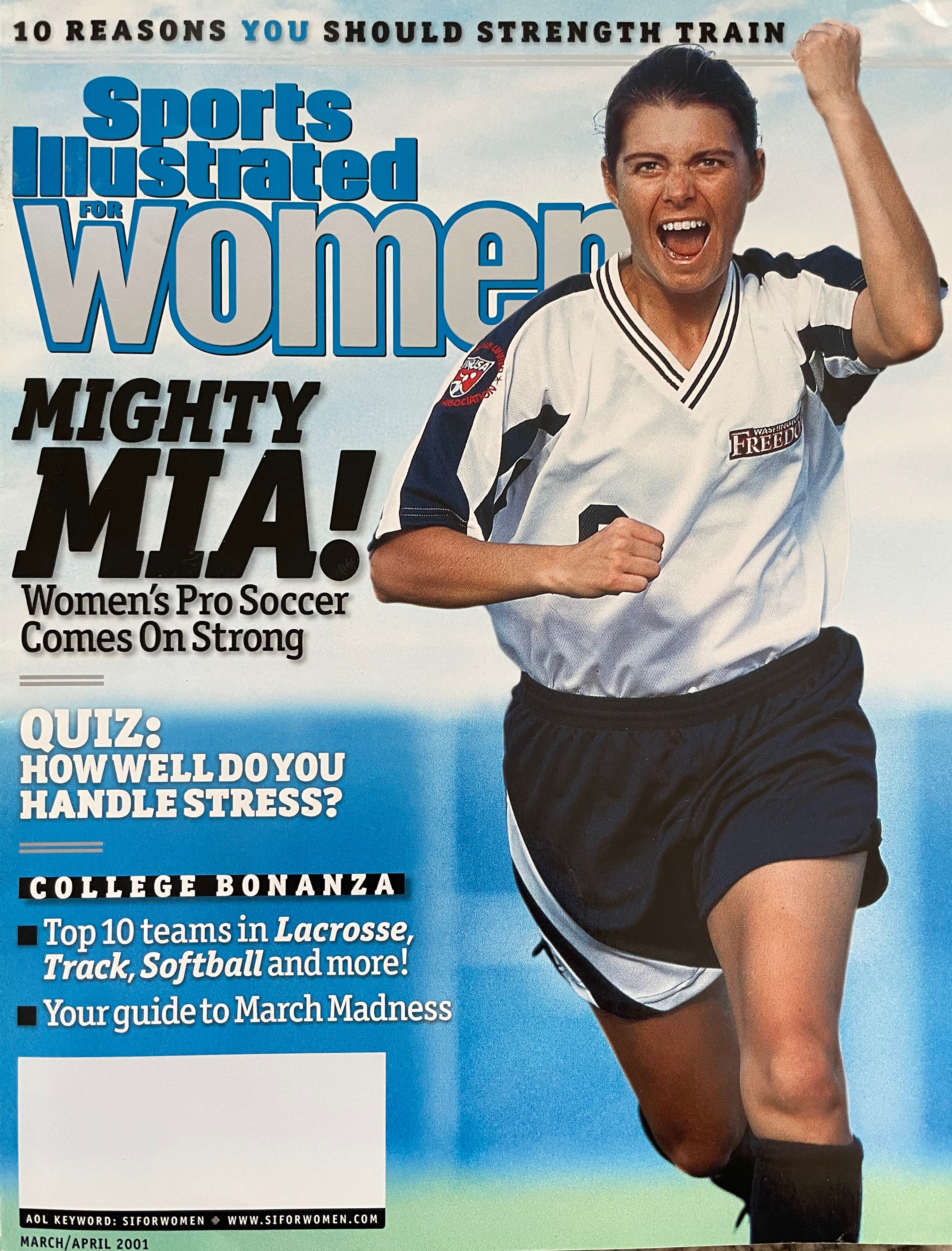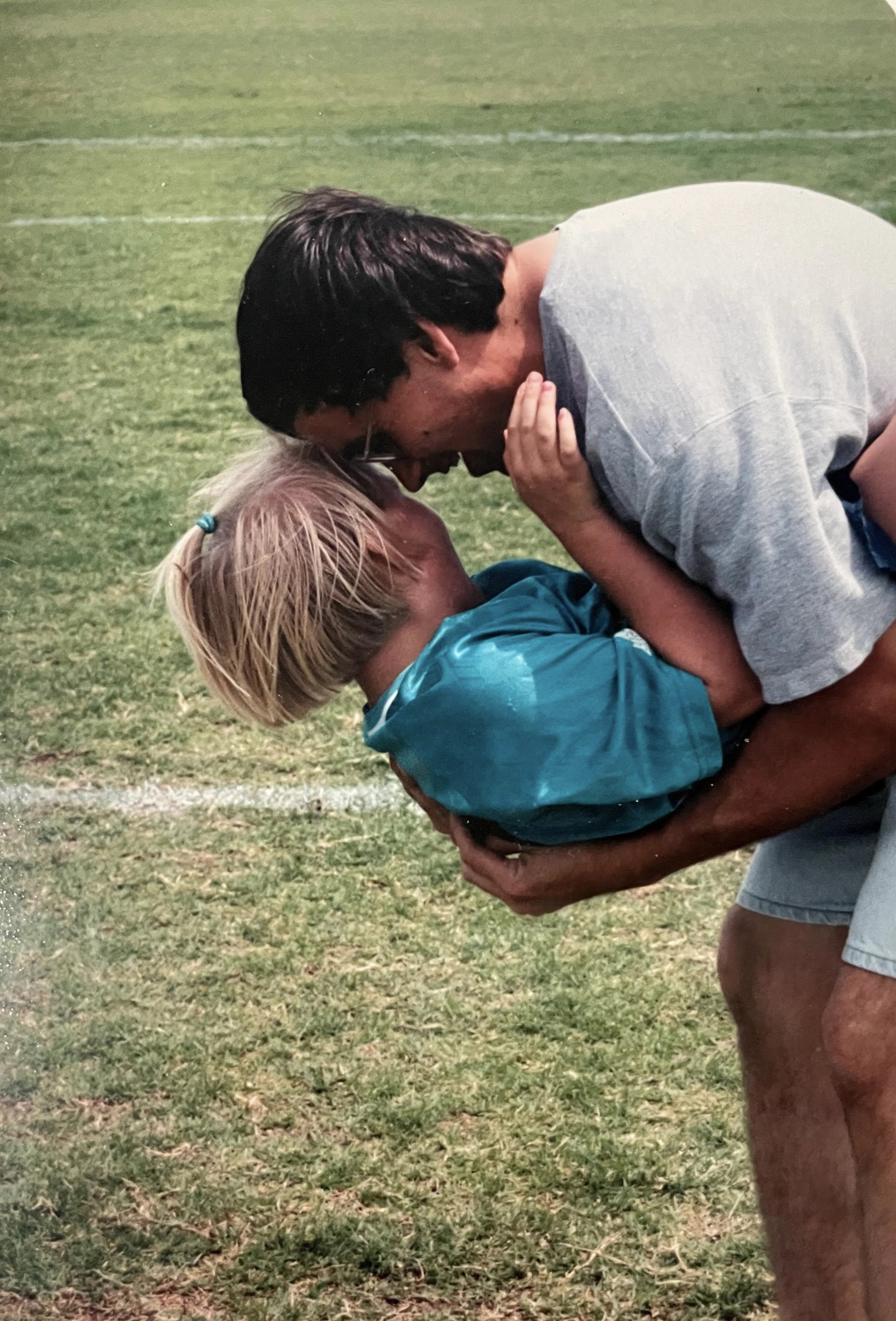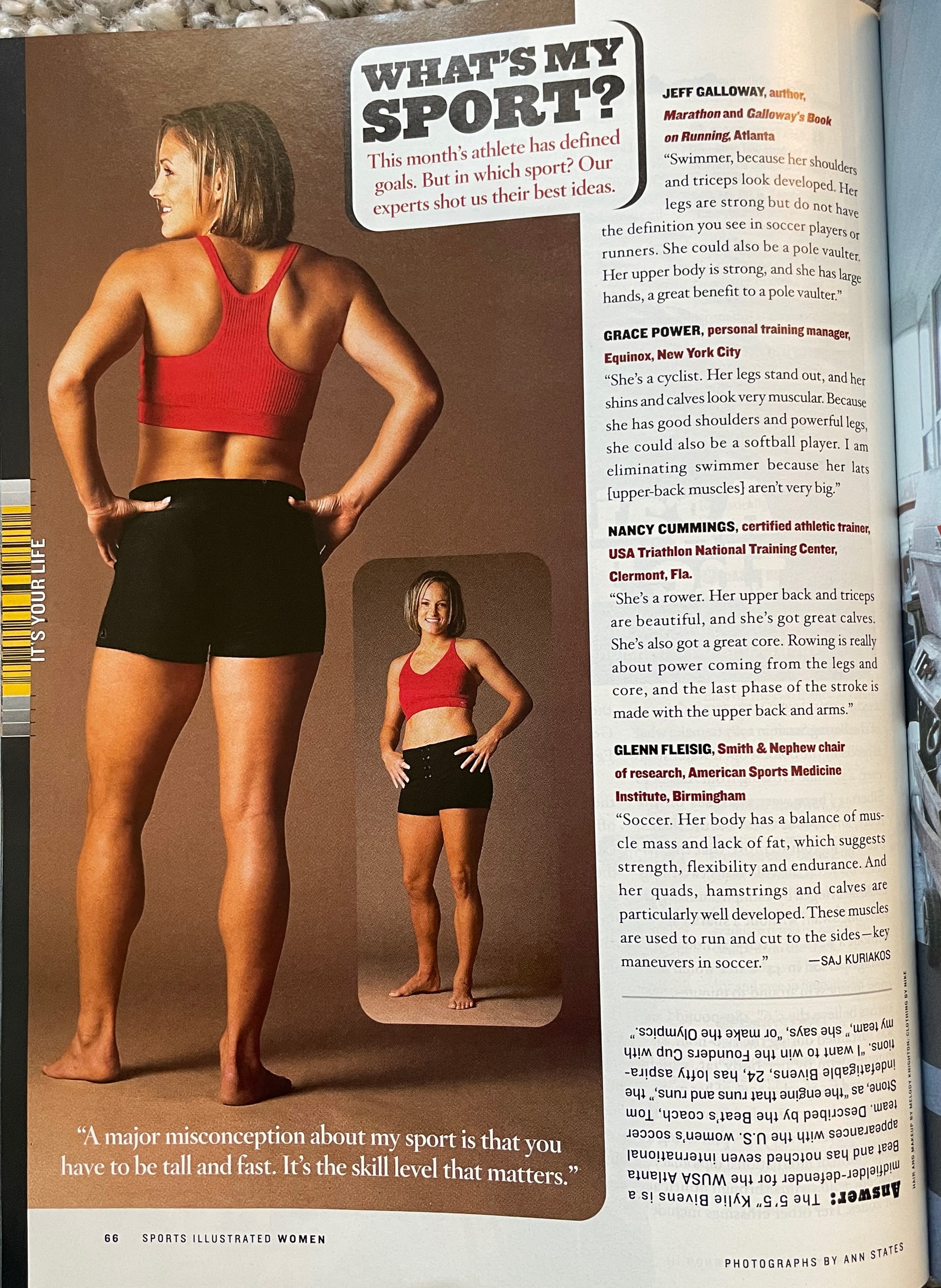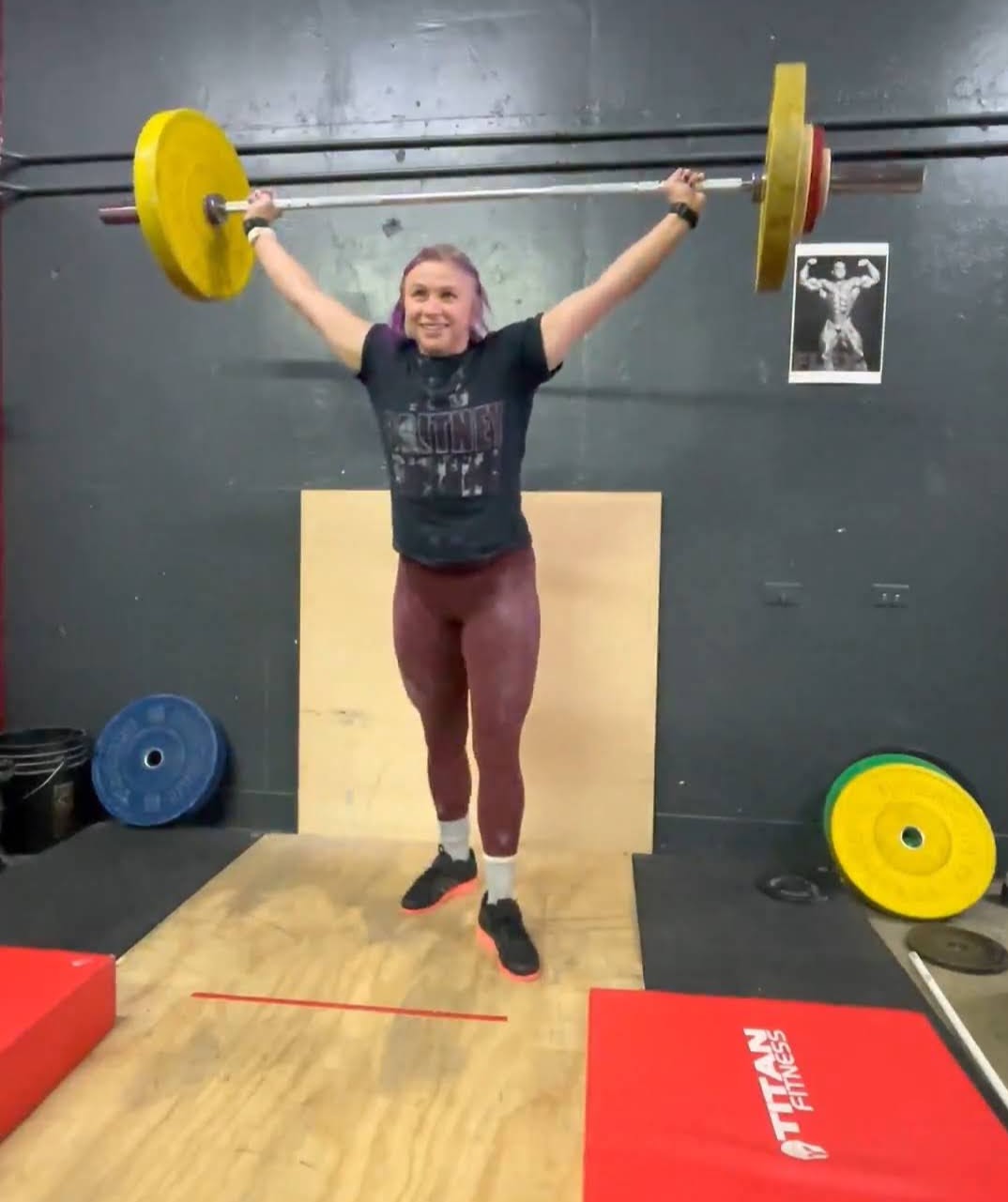One of the clear dividing lines in my life is the first time I received an issue of the magazine Sports Illustrated for Women in the mail. A sister magazine to the renowned sports monthly Sports Illustrated, SI for Women focused wholly on women’s sports, unlike any sports media (or women’s magazine!) that I had ever seen. Every cover featured one or more women athletes, and the magazine’s content covered an impressive variety of sports, as well as relevant topics for athletes, such as strength training, proper nutrition, and balancing training and life, all centered on women and their stories. My aunt, a former college basketball player turned coach and my first model of a woman athlete, signed me up for a subscription as a surprise when the magazine debuted. I was absolutely thrilled. Every time an issue arrived I read it cover to cover, multiple times.

Cover for the March/April 2001 issue, featuring Mia Hamm.
SI for Women was unfortunately short-lived, only in circulation from March 2000 until December 2002, for a total of 20 or so issues. But its tenure overlapped with a critical time in my life: somewhere between the ages of 8 and 10, both deeply in love with multiple sports and facing a fair amount of personal turmoil. Around that time, my family was caring for multiple grandparents whose health was in rapid decline. We moved houses (and schools) to accommodate my great-grandmother’s permanent residence with us as her dementia progressed; other grandparents would regularly stay with us for care as well. Budding body image issues planted in earlier years began to crystallize as I approached puberty, compounded by class culture shock from starting 5th grade in a new school whose student body was generally much wealthier than my previous one.
Sports were a core part of my identity then, and they are now, too. Over the course of my life, I’ve had many athletic pursuits, including, in more or less chronological order from pre-K to my current age:
- soccer
- softball
- basketball
- a variety of martial arts, from karate to MMA to krav maga
- pole vaulting
- track (400m, 100m hurdles, and 4x200m relay)
- cross-country
- rugby
- yoga
- hiking
- backpacking
- distance running (half-marathon and marathon)
- trail running
- powerlifting
- bodybuilding
- rollerblading
- rollerskating
- olympic weightlifting
Still, if you had asked me until very recently if I considered myself an athlete, I would’ve emphatically declined. In environments with other athletes, I never felt I was a standout in the room. At the same time, I’m generally athletic, somewhat coordinated, naturally very strong, and relatively fast and explosive. None of these qualities have anything to do with being an athlete, though; it was a matter of how much I felt I deserved the title.
As a child, I had no qualms about calling myself an athlete, particularly in soccer and basketball. I have been competitive for as long as I can remember, and sports were a healthy outlet for my ruthlessness. Nothing made me feel more powerful than being aggressive on the field or court and seeing fear in my opponents’ eyes after they witnessed my strength and skill. At the same time, sports taught me how to work with others, even in tough situations, and showed me the value of dedicated practice both as an individual and a team. The nerdy side of me loved indulging in discussions of strategy, plays, and technical details; my favorite soccer skill to practice was the highly technical corner kick. Sports were also incredible for my self-esteem. Once, for a writing class, I wrote a short story from the perspective of myself playing soccer as a girl, and a reviewer commented that the unabashed self-confidence and positive self-talk in the narrative was unbelievable from the perspective of an adult woman. But that’s what playing sports did for me.

Celebrating with my dad after a soccer game as a child.
As I grew older, a combination of outside influences led me to gradually quit sports, eventually leaving completely around the age of 15 for many years. As these influences pushed me out of sport, I lost part of myself in the process, including a fair amount of confidence and self-love that playing sports had helped me to cultivate. By that time, Sports Illustrated for Women was no longer in print, and I had stopped re-reading my issues.
Some contributing opinions that led me to leave sports were well-intentioned. For example, I always excelled without much effort at school. Many adults impressed upon me how much more important school was for my future than sports; it would be great if I could go to college for soccer, but it would be better to get an academic scholarship instead, which was in the cards for me. I remember people telling me to never quit school; I don’t remember anyone telling me it was important to stay in sports.
Misogyny, compulsive heterosexuality, and the particular fatphobia of the era (the 2000s) contributed, too. Men of all ages made comments about my natural strength — and my joy in showing it off — being unattractive, and I was strongly conditioned to care about their opinions. My male peers, emboldened by a culture that dismisses women’s athletics, told me that my athletic accomplishments didn’t matter because I was a girl, or that I would never beat boys at my sport. (I routinely took this on as a challenge and delighted in proving them wrong.) As I got older, my body as well as my tomboy fashion preferences seemed to invite comments about what athletes, and girls in general, should look like. The idea of a single athletic body type is obviously just plain wrong — one of the things I loved about Sports Illustrated for Women was a regular feature where they highlighted how a variety of athletes’ bodies made them perfect for their sport!

SI Women had a regular feature called “What’s My Sport?”, which depicted an athlete and a clue about what sport she played. The featured asked “experts” to guess what her sport was, with the answer revealed at the bottom. (The “experts” were very often wrong, and I found them to be the least interesting part of this feature.)
Still, I didn’t have the “right” body to many people. From the time I was a baby, I was usually larger than my peers (I was in the 97th percentile for my weight at 3 years old), and I was mocked for my weight and size by adults and children alike. As I approached puberty my body became the subject of more and more discussion from fellow athletes and coaches, who would make unsolicited comments about what I should or shouldn’t eat. I began to dread visits to the doctor because my pediatrician would lecture me with unactionable advice about “diet and exercise,” which I found especially frustrating given that forms of exercise (soccer, basketball, martial arts, riding my bike daily) were literally my favorite things to do. Looking back, I realize I began to engage in disordered eating as far back as middle school. I remember deciding to quit cross-country before high school because I was scared to wear the much tighter, cropped spandex uniforms that the high school runners wore, for fear of having to expose my stomach.
A particularly egregious example of fatphobia’s impact on my athletic career and health was an incident in middle school basketball practice. While doing full court sprints, I experienced the first of several tachycardiac attacks in my life, in which my heart will race up to 220 bpm after a quick jump into intense exercise, making me feel faint, or even like I am dying. I told my coach that something was really wrong. She dismissed me, downplayed my symptoms, and told me if I lost some weight, then maybe my heart wouldn’t beat so fast when I was sprinting. I still occasionally experience these attacks regardless of my current level of fitness and body weight — I had one most recently when I was peaking to run my second marathon, in the best aerobic fitness of my life.
In college, I slowly started to dip my feet back into the water of athletics. I tried rugby, but experienced an onslaught of new awfulness from some people around me — particularly fatphobia and homophobia, as much of the team was queer. I left after a few months, even though I enjoyed the sport a lot. But I slowly started running again. After graduating, I began attending group fitness classes and found that I really liked the stress outlet they provided. But my primary goals were centered on making myself smaller and were never about athletic performance — after all, what was my sport? I was self-aware of how much I had internalized the idea that I needed to make myself thinner and wanted to have other goals, but that desire alone wasn’t enough to shake the deep-rooted poison that made me want to shrink myself. I started lifting weights (first powerlifting, then bodybuilding) to try to build muscle as a countermeasure. Still, I was terrified of weight gain even as I gained muscle and grew stronger.
At the start of the COVID-19 pandemic, like many others I found myself turning to the hobbies of my childhood for comfort and novelty, particularly in the early days where I stayed home almost all the time. I bought a Lisa Frank coloring book pack; I revived my love of Dance Dance Revolution by getting a step pad and playing the open source clone StepMania.

The Lisa Frank art pack that entertained me for much of the early pandemic.
I didn’t feel comfortable going to the gym anymore, so I sought alternate sources of outdoor athletic stress relief, like rollerskating, rollerblading, and ramping up my regular running schedule to train for a marathon. I even got a soccer ball, the first one I had owned in more than a decade. Once I was vaccinated, I was eager to get back to lifting weights, and I signed up for an olympic weightlifting gym to try a strength sport that had caught my eye years before but had been too intimidated to try.
The experience of finding the sport of olympic weightlifting was indescribably magical; if you know me at all, you’ve heard me talk about it. In short, olympic weightlifting involves competing in two lifts, both of which start with a loaded barbell on the ground and end with the bar raised overhead. In the snatch, the lifter does this in one fluid motion; in the clean and jerk, the lifter first cleans the bar to their shoulders, pauses, then lifts the bar overhead with the jerk. The goal is to lift as much weight as possible for both lifts, and to do so requires strength, mobility, strong body awareness, mental focus, and explosiveness. (Some of the best olympic weightlifters are former competitors in gymnastics, a sport with similar demands.)
In the snatch, the lifter begins by holding the bar with a wide grip. In one motion, the lifter lifts the bar from the ground, generating enough height such that they can pull themselves into a squat (either partial or full) underneath the bar and lock out their arms straight and overhead. The lift is complete after the lifter has stood up with the barbell, with their feet in line, in control of the bar.
The clean and jerk is a two-part lift. In the clean, the lifter begins with a narrower grip, lifting the bar from the ground, high enough such that they can pull themselves underneath the bar into a “front rack” position, with the bar resting on their shoulders. The lifter must stand up and cease motion before beginning the jerk. In the jerk, the lifter dips and drives up with their legs to generate force to send the bar overhead. The lifter must receive the bar with their arms locked out overhead, which requires some bending of the legs in the receiving position. The lifter can receive the bar in a squat, partial squat, or split squat position; these refer to the squat jerk, power jerk, and split jerk variations, respectively, with split jerk being the most common style and the one depicted in this video. The lift is complete when the lifter has stood up, with their feet in line, bar overhead and in control.
Weightlifting requires a lot of the nervous system because the athlete is lifting heavy weight from the ground to overhead, using practically every muscle in the body, in just a few seconds. Consequently, the practice rewards taking care of one’s central nervous system through stress management, sleep, and good nutrition (not depriving oneself of food!). Something I noticed immediately about the sport was that there are excellent olympic lifters of all sizes — in fact, the people who can lift the most weight are generally also those who weigh the most. The world’s treatment of fat people seems only marginally better now than when I was a child, but seeing athletes, particularly women, celebrated regardless of their body size was very powerful.
Olympic lifting also deeply appeals to the analytical, curious side of me. The olympic lifts are highly technical and in my opinion, extremely nerdy; they can be endlessly analyzed for perfect technique, and lifters improve by breaking these complex lifts down into smaller components and improving strength and technique in specific positions. The sport connects my brain, my natural strength, and the athleticism of my body in a way that I’ve never experienced in any activity, athletic or otherwise. I often think to myself how this sport feels exactly made for me. It gave me a new set of goals to strive for in my fitness pursuits, ones based on performance, consistency, and mental fortitude.
There was something special about the gym that I joined, too; the belief my coach and my fellow lifters (mostly women) had in me and my potential in the sport was invigorating. In my gym, I am celebrated for my strength and accomplishments, and no one cares what I weigh or what I look like in low-rise jeans. Olympic lifting and the community I found through it helped me to reclaim my lost identity as an athlete, reconnecting me to a deep joy and love for sport that is surely an innate part of me. In the process, I found that I grew a desire to take up space, love my natural strengths, and take care for my body rather than fighting against it. At last, I revived the confidence and self-esteem I once had as that fearless girl on the soccer field.

A potato-quality image of me extremely happy after a hard-earned snatch PR. My shirt says, “It’s Britney, b*tch,” which I wore to celebrate Britney Spears’ then recent release from her conservatorship. I love the juxtaposition here: cheering the newfound freedom of a beloved celebrity of my childhood — another victim of early-to-mid-aughts culture — and a visual depiction of the mental freedom I found in the sport of olympic weightlifting.
Something that has been heavy on my heart lately is the growing wave of vitriol directed toward trans people in the United States, with a systematic focus on banning trans children from playing sports. In addition to the deep sadness I feel seeing adults and generally people in power making a great effort to behave so cruelly to literal children, legislation that keeps trans children from playing sports strikes a particularly painful nerve for me. Throughout my life, sports have been a critical catalyst for developing self-esteem, improving my mental health, and aiding emotional development, even in times where outside messages told me to hate my body and myself. Depriving trans children of an experience like this, one that could be incredibly affirming for them in a world that may send them similar messages, is unconscionable.
A common refrain is that keeping trans people out of sports somehow protects women’s sports, which is a laughably stupid, insulting, and ironic claim. It is one I find especially worrying, as I hear it echoed in women’s sports corners of the internet that are usually quite progressive, and have even heard repeated by other queer cis people in real life. It is worth considering the source of this claim and who it benefits. For one, this is the only time I have ever seen such a large group of people clamor that women’s sports must be “protected.” Yet the continued absence of women’s sports from sports media and other inequalities such as pay inequity, make clear that women’s athletics have been and continue to be dramatically undervalued and disrespected. Where have all these ostensible supporters of women’s sports been until now? It is clear that the argument for “protecting women’s sports’’ is a thinly veiled disguise for blatant transphobia — implying that trans women are not women — and paternalistic misogyny — no one ever claims that men’s sports must be protected from trans athletes. Instead transphobes (in power and otherwise) hold up women’s sports as a faux-feminist beacon to convince supporters, perhaps even ones who believe they support trans people, that somehow discrimination (and abject cruelty) is a moral choice, and to suggest that trans rights and women’s rights are mutually exclusive, when in fact they are deeply connected. Trans people belong in sports, and all sports, including women’s sports, are made better by being inclusive to everyone. I hope that anyone who reads this with doubts about this idea considers my experience as a pained child who was repeatedly told her body and gender expression were not okay and how sports empowered me to love myself in spite of that.
Even better than hearing my story is listening to what trans athletes have to say about their relationship with sports. I would encourage all cis people to be curious about their experiences. Some of my favorite athletes are:
Angel Flores, a powerlifter and olympic weightlifter, who was featured in the tv show Queer Eye (Season 6, Episode 2). She wrote a great blog post about her experiences transitioning as an athlete, anchored to the perspective of what’s going through her head during a powerlifting competition.
Chris Mosier, a triathlete and the first openly trans man to represent Team USA, who was profiled for Rolling Stone in 2016 after qualifying. He runs Transathlete, “a resource for students, athletes, coaches, and administrators to find information about trans inclusion in athletics at various levels of play.” The site features a page to take action against legislation in the United States targeting trans children in sports.
Janae Marie Kroc, a trans/nonbinary/genderfluid elite powerlifter and bodybuilder. In this interview she discusses her experience transitioning as an already well-known bodybuilder and powerlifter, as well as the documentary made about her, Transformer.
After discovering olympic weightlifting as an adult, I affirmed how much sports had really meant to me throughout my life, and I reclaimed an identity — athlete — that I had been made to believe could not belong to me. Not coincidentally, I began to wonder about the women’s sports magazine I had once treasured so deeply. I acquired some issues and have enjoyed reading them again, in part for the fond memories and nostalgia. But I also marvel at how ahead of its time the publication feels. In sharp contrast to other women’s magazines of the time, particularly ones about fitness or health, SI for Women glorified women for their athletic achievements, repeatedly highlighted the importance of eating enough food to fuel yourself for sports and health, and treated women’s sports seriously in a way that men’s sports has always been treated. I also stumbled upon an almost poetic discovery: Even though I only recall learning about the somewhat obscure sport of olympic weightlifting a few years ago, SI for Women had been covering it all along. Multiple issues feature a young Cheryl Haworth, who represented the United States in the first year weightlifting was opened to women at the Olympics (2000) and won bronze at just 17 years old.

After Cheryl Haworth won bronze at the Sydney Olympics, SI Women featured her in a full page photo in the November/December 2000 issue. Haworth still retains the title of heaviest snatch by an American woman, lifting 128 kg at the 2003 USA National Championships.
I have asked many people I know if they remember the magazine Sports Illustrated for Women, and so far, I haven’t found another person who does. So I decided that I wanted to share more about this gem of a magazine and my connection to it with more of the world. I would love to show others what so much of sport means to me, how important coverage of women’s sports is for girls and women, and why we should care about making sport inclusive for everyone. But mostly, I just love Sports Illustrated for Women, and I think it would be fun to read it again, cover to cover, one more time.
>> Home